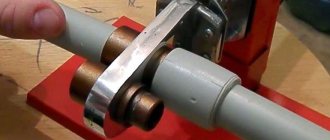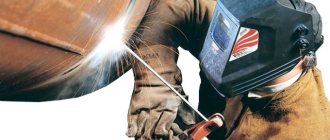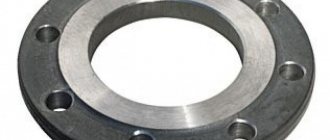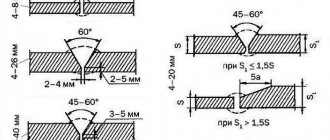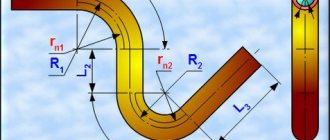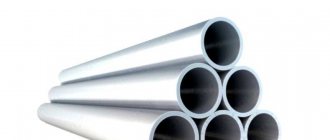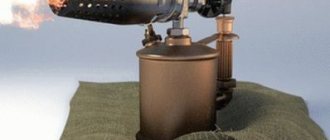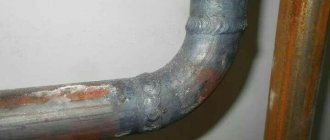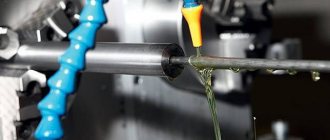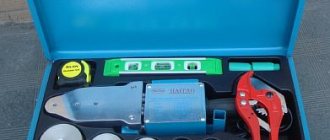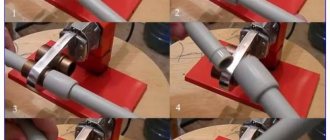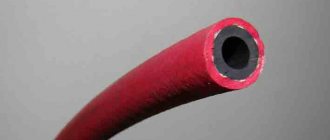Without reliable fixation of pipes during joining, it is impossible to obtain a reliable connection even if the welding work is carried out by a high-class worker. Manual installation and fixation in the desired position takes more time than applying a suture. Therefore, when installing pipelines, a welding centralizer is used, which simplifies and reduces the time required to complete the work.
Features and purpose
When loose pipes vibrate and move during connection, the seam becomes loose and can therefore crack even with minimal load. Therefore, the use of centralizers for welding pipes through which substances that are aggressive or hazardous to human health are pumped is mandatory. They can be used at temperatures from -45 to +45˚C. The accuracy of the alignment of the axes when assembling pipes for welding reduces the resistance coefficient. Therefore, the power of pumping units is reduced.
Depending on the design features, centralizers are used for joining diameters from 25 to 2000 mm. The basis of the design is the body, complemented by a stand or hook and a set of clamping elements. Their number can be changed depending on the diameter of the parts being connected. The equipment is attached to the pipeline on one or both sides of the joint and tightened with a tension mechanism, tightly connecting the ends.
QUESTIONS ABOUT SELECTING A CENTRATOR
1. Pipe diameters?
2. Pipe wall thickness?
3. Steel grade with coefficient. strength (Mpa)?
4. Welding technology (manual arc welding, orbital welding, etc.)?
5. Should I use one centralizer for the entire range of pipe diameters or a separate centralizer for each diameter?
6. Required type of centralizer: external centralizer (chain, screw, clamp, eccentric), internal centralizer (manual, pneumatic, hydraulic)
7. Is it necessary to correct the ellipse of pipe joints before welding, types of deformation of the pipe edge (ellipseness, dents)?
Read also: Current converter 12v 220v
8. Is it necessary to weld pipes with bends (T-shaped, L-shaped)?
9. Other operating conditions (temperature, precipitation)?
External centralizers for pipe welding
Their marking consists of the letters CN and a number indicating the maximum permissible diameter in mm. Common types include:
- Multi-link centralizers cope with diameters up to 2 m. They are assembled from elements connected by hinges. The links are tightened manually using a tension screw or hydraulic cylinder. Internal centralizers are more often used for joining large diameter pipes
- Arched varieties consist of two terminals with folding elements, which overlap each other during operation and are then pulled together by a manual or hydraulic mechanism. Designed to work with pipes with a diameter of up to 0.9 m. They are more durable than the previous version, since there are no hinges whose fingers wear out quickly. The number of arches is selected depending on the diameter of the pipes.
- Chain varieties are quickly brought into working position, therefore they are used for laying new and repairing emergency pipelines with a diameter of up to 1.4 m. However, the chain can only be tensioned manually.
- Eccentric devices are similar to arched devices, but the terminals are tightened with an eccentric clamp. When working, high skill is required from the worker, since an incorrectly fixed eccentric can become detached during welding. The disadvantages include rapid wear, which weakens the clamping force. The scope of application is limited to diameters of 0.4 - 0.5 m.
- Clamp-type centralizers are used to connect domestic pipelines with a small diameter. The advantages include compactness and manual clamping using a lever mechanism. The shape of clamps can be rectangular or arched.
- Spring types are indispensable for joining casing pipes underground when drilling wells. The household version is used for laying metal, polymer pipelines and with polyurethane foam.
Types of centralizers
There are two ways to divide pipe centralizers into subtypes. They are divided based on the area of fixation and the method of fastening.
According to the fixation area, the guide mechanism for polyurethane foam or metal pipes can be internal or external.
- Internal devices are installed inside the connected sections to fix polyurethane foam pipes or any other materials in the correct position. This equipment is used, as a rule, on large diameter pipelines. It has a rather complex design and includes hydraulic pumps, an engine and locking mechanisms.
- The external centralizer grips the welded joint from the outside. It is a fairly massive clamp with a universal design. It is simpler and more convenient to use.
Centralizer internal
If the internal mechanisms can only work due to hydraulic pumps, then the external ones can be divided into several more categories according to the method of fastening polyurethane foam or any other products of large and small diameter at the joints of pipes.
- chain A chain is attached around the joint using special tensioners, which secures the sections for welding;
- link This device consists of a set of links that can be moved and adjusted based on the diameter of the pipe;
- eccentric. Such centralizers consist of two metal arcs, which are connected by a jumper.
In addition to the main, most commonly used guides, there are several less popular devices:
- external casing spring centralizer. It is used, as a rule, during vertical drilling, to connect pipes of a polyurethane foam well. Such equipment looks like a metal pipe cut along the perimeter with a convexity at the cut points. It is this convexity that gives the equipment a spring effect;
- mobile household devices for connecting small diameter polyurethane foam pipes.
Installation of the unit
The installation of external centralizers is somewhat different from internal ones. It is performed more simply and quickly.
The process of welding metal pipes using an internal centralizer
Installation procedure for the internal device:
- We clean the joints to be connected.
- We fix the unit in one of the elements.
- We fix the spring centralizer near the edge of one of the segments.
- We install the second element close to the first.
- Let's start the engine. Hydraulic pumps compress the sections, leveling them due to the internal diameter.
- Checking the correct connection.
- We cook the joint.
Installation procedure for outdoor device:
- We prepare the joints.
- We install the unit.
- Align the segments by level.
- We tighten the centralizer bolts.
- Checking the correct connection.
- We clamp the tensioners until they stop.
- Let's start welding work.
How to choose a centralizer?
Choosing a centralizer for welding pipes is perhaps one of the main tasks when arranging a water supply, sewerage or heating pipeline.
Centralizer for welding polypropylene pipes
It is this equipment that will allow the pipes to be hermetically connected and maintain the correct slope angle, which is the key to the reliability and durability of any pipeline. The nuances are:
- Decide what cross-section of pipes you will have to deal with. An open unit is quite suitable for working with elements of small diameter (up to 500 mm). To connect products from 500 mm, it is better to use a closed device. It is more difficult to control, but provides a more reliable fixation.
- To choose between chain, link and eccentric models, decide on the amount of work and the thickness of your wallet. Chain models are the cheapest, most functional, but least reliable. Link devices are average in all respects. The most expensive, but most reliable are eccentric centralizers. However, for household pipelines, throwing out $150-200 on auxiliary equipment is at least not rational.
Internal centralizers for pipe welding
The hydraulic drive of this equipment ensures internal centering of the pipes and eliminates deflections. They can appear under the influence of their own weight or from soil movements. Adjustment of the movement speed and clamping force is carried out using a DC motor mounted on a hydraulic drive. On pipelines with a diameter of up to 0.3 m, it is possible to use a manual drive.
When joining with an internal centralizer, it is inserted inside the pipe, and the second one is pushed in using a lifting mechanism. The ends are pressed using a hydraulic drive, and the joint is welded. A fan is used to prevent the pipes from becoming too hot during welding. The equipment is removed with a special rod, then inserted into the next joint. Movements are carried out until the completion of pipeline installation.
Internal centralizers are more often used for joining large diameter pipes
Main types of centralizers
All mechanisms that are on sale today can be divided into two categories. These are internal and external centralizers.
The internal centralizer for pipes is designated “CV”. It is a hydraulic installation. Equipment of this type pushes the edges of the connected pipes from the inside, shifting the media towards each other. The advantage is the ability to use the tool for products of different diameters.
Choosing the right centralizer
In order not to make a mistake with your choice, you need to take into account the recommendations of experts:
- For working with large-sized polyurethane foam pipes, internal centralizers are unrivaled.
- For pipes with a diameter exceeding 0.8 m, it is recommended to make connections using rigid arched or multi-link devices for outdoor installation. For smaller sizes, eccentric options will provide sufficient clamping force.
- If the pressure of the pumped substance exceeds 5 atm, a centralizer with a hydraulic clamp is selected.
- If there are increased requirements for the quality of the welded joint (for example, ellipse), a chain centralizer is selected.
- In terms of versatility, chain-type devices occupy first place.
Purchasing a centralizer is necessary if you often have to lay or repair pipelines. The high cost of additional equipment will pay for itself many times over by reducing repair costs and increasing the service life of water and heat supply communications. Especially if they are laid underground.
What does the device consist of and how does it work?
At its core, a centralizer is a device that connects the welded joints of two pipes in a perfectly even position. The design allows it to be used for working with pipes of various sizes. It is easy and quick to install and weighs relatively little.
An external centralizer for pipes of any type consists of a connecting device (plates, clamps or chain) and a tightening part (screw gate, bolted connection, hydraulic drive).
To connect two pipes, follow a simple algorithm:
- Clean their joints using an angle grinder, remove rust and other contaminants with appropriate chemicals (rust neutralizer, acetone, white spirit, etc.)
- Place the centralizer on one of the pipes, but do not tighten its fastenings.
- Bring the second one into contact with the first one.
- Move the centering device to the second one and tighten the fasteners with uniform force.
- A visual check is carried out for the correct position of the pipeline and the reliability of the centering device.
- Sutures are applied using gas or electric welding.
As the seam is being applied, the centering device must be carefully loosened and rotated, freeing up the working area for welding. During this procedure you need to be especially careful, as it is easy to deform an unfinished weld seam
What is a centralizer?
Every welder knows that reliable fastening of the welded elements is the key to a good result. If pipes prepared for welding are not centered and secured securely, they may vibrate and oscillate during operation. This will lead to the seam being bulky, weak and unreliable. At the slightest load it can leak or even burst.
Such negligence is not acceptable even when installing small-diameter household pipelines with low pressure and no external load. As for industrial, especially underground, highways, such irresponsibility can be very expensive in the future.
Their task is to securely fix the pipeline joint to ensure a high-quality weld.
Connecting and aligning metal parts using a centralizer
Centralizers consist of a device body (tensioning mechanism), a stand or hook and individual set elements, changing the number of which allows you to connect lines of different, including small, diameters.
This equipment is fixed around the junction of two pipes prepared for welding and pulled tightly using a tensioning mechanism.
In other cases, an external one is used. This is due to the fact that the internal guide device is more expensive and much more difficult to install.
We also note that the centralizer for welding polyurethane foam pipes of large diameter is a rather bulky and heavy device. Therefore, its use requires the use of additional equipment.
Advantages and disadvantages
Like any device, pipe centralizers have their advantages and disadvantages.
The advantages include:
- wide functionality. There is no need to purchase guides separately for each diameter;
- ability to work with both metal and polyurethane foam pipes;
- high-quality and reliable fixation of connected elements;
- the presence of two modifications - internal and external, which allows you to fix sections in any conditions and workspaces;
- ensuring high-quality welds, which are the key to pipeline reliability.
Centralizer for butt welding of polyurethane foam pipes
The disadvantages of this equipment are associated, first of all, with its bulkiness.
- quite high price. However, we note that if you are constantly welding pipelines, centralizers will pay for themselves in a short time;
- complexity of the design. Working with this equipment requires certain knowledge and skills;
- bulkiness and heavy weight (when it comes to welding large-diameter steel and polyurethane foam pipes);
- When connecting large diameter sections, the use of special equipment is required.
Although pipe centralizers have a number of disadvantages, there is nothing more reliable for welding pipelines, especially for industrial purposes. This device will more than pay for itself thanks to the installation of reliable pipelines that will last for years.
Advantages and disadvantages
The main advantages of centralizers include:
- improving the quality of welding due to precise positioning and fixation, which ensures a long service life;
- reduction of labor costs;
- mobility;
- low cost;
- multifunctionality, consisting in applicability for pipes of different types and sizes.
The main disadvantage of centralizers is considered to be a slight increase in the cost of work. In addition, many industrial models are characterized by large mass (up to hundreds of kg). Therefore, their use requires lifting devices. This also complicates and increases the cost of work.
You can also compare the external and internal views.
Tools of the first type are characterized by the following advantages:
- small dimensions and weight for most models;
- ease of use;
- Possibility of use under any conditions.
The main disadvantage is the fragmentary execution of work due to the need to constantly move the tool.
The main advantage of internal centralizers is to ensure continuous welding. However, these are large and heavy instruments with complex designs that require lifting equipment.
Domestic
Internal centralizers make it possible to mechanize the pipeline assembly process, while the joint is entirely accessible for welding, the seam is applied continuously, without installing tacks. The use of centralizers greatly facilitates the work of the welder, as it allows you to apply the entire seam at once and without stopping.
Depending on the size of the pipes, centralizers can have different designs:
- internal hydraulic centralizers - used for centering both individual pipes and sections, and the device is moved from joint to joint using a special rod;
- manual with spacer wedges - automatically centers pipes, including those with different diameters;
- scissor - depending on the model and design, they can center pipes not only of the same, but of different diameters.
Internal ones more evenly distribute the difference in perimeters relative to each other throughout the entire joint. They are able to correct minor dents, deviations from cylindricity and bring the ends to the correct circle.
If a large main pipeline is being built, then self-propelled hydraulic centralizers are used. They are capable of moving long distances via remote control.
Internal (spacer) centralizers provide the most accurate alignment of pipe edges, since the inner surface of the pipe is considered the base. Sufficiently powerful mechanisms can align edges and are used as expanders. They increase the degree of mechanization and assembly productivity of almost all sections of the pipeline.
https://www.youtube.com/embed
Centralizer application technology
Installation of a centralizer for polypropylene, metal and other types of pipes is carried out according to the standard scheme:
- Before installing the fixing equipment, it is necessary to prepare the ends of the pipes for welding. To do this, their surface is cleaned of dirt, rust, paint residue and other deposits. During the work, you can use various devices and solvent;
- the ends of the pipes are brought to each other and connected by a centralizer;
- The device is fixed to the pipes.
You can learn about the types of household centralizers and how to use them by watching the video.
Before welding, check the secure fit and, if necessary, reinstall and/or tighten the centralizer clamps.
Experienced craftsmen and ordinary people who perform welding work know that the preparatory stage does not take more time than the welding process itself.
A significant part of the time is wasted on assembling the welding structure and installing all the elements in the desired location.
In everyday life, a large number of mechanisms and structures are used for welding pipes. These auxiliary devices are most often manual and universal.
They help to quickly assemble a structure with securely fastened parts, and also allow you to do the work with virtually no deformation.
